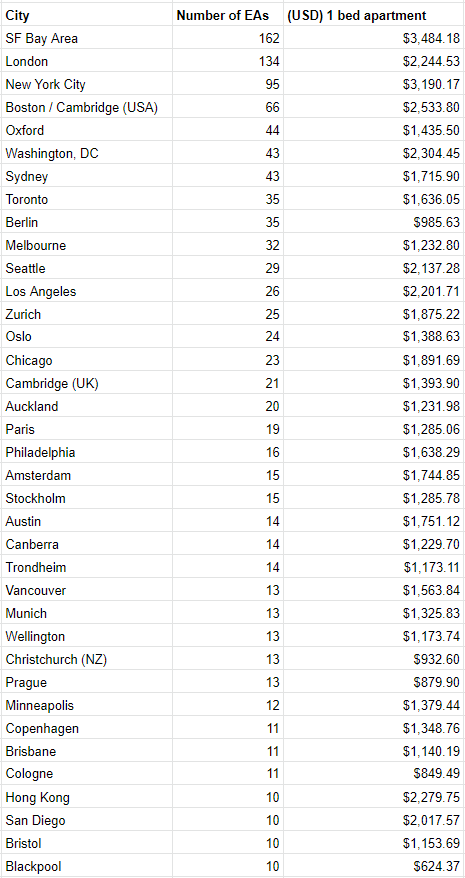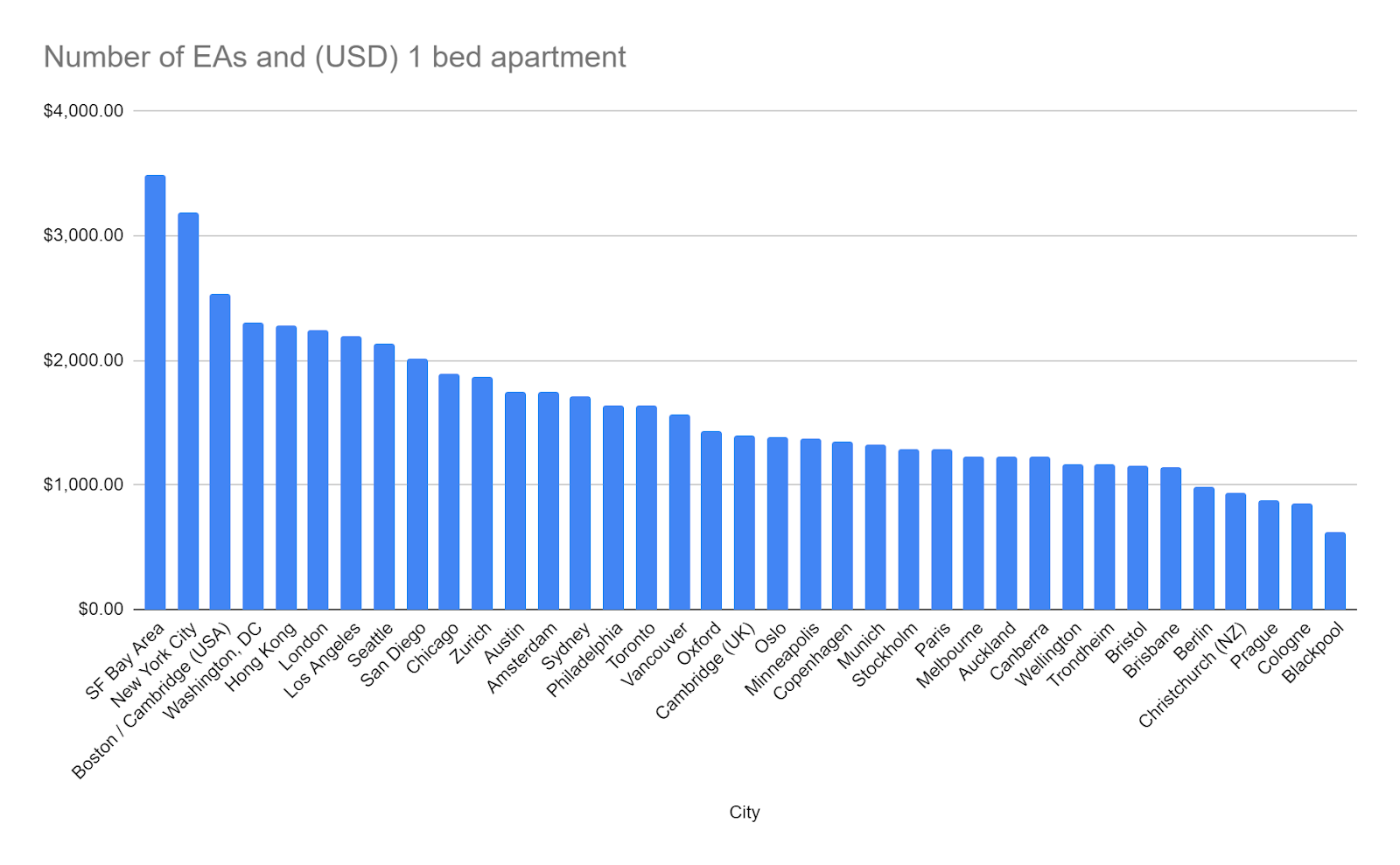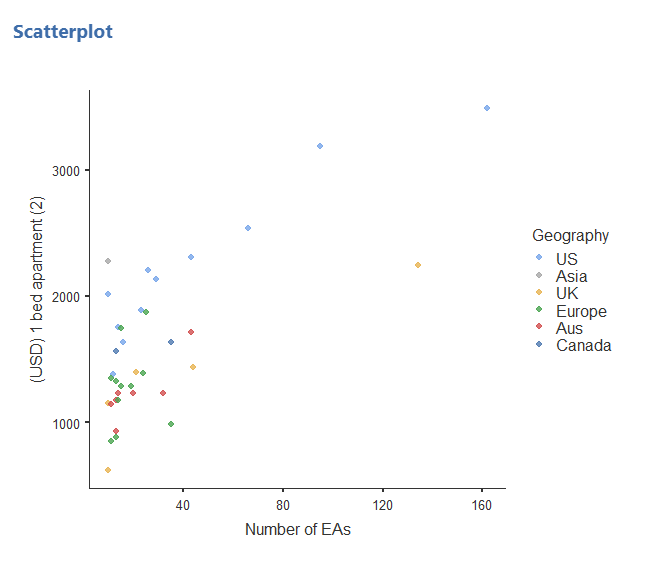Summary
- We examine the cost of living in the cities with the largest numbers of EAs
- Most cities with large EA populations are very expensive to live in
- This may pose a barrier to EAs wishing to live and work in cities with lots of EAs
Many EAs are interested in living in cities with a significant number of other EAs. However, the main EA hubs (San Francisco and London) are notoriously expensive. Given this, we thought it might be interesting to look at the cities which have a significant number of EAs living in them and examine the price of rent in these locations.
To do this, we used EA Survey data to find every city which had 10 or more EA respondents. We found 37 such cities. We then examined the estimated price of a one-bedroom central apartment on Numbeo.com.
Some preliminary things to bear in mind:
-
The true number of EAs in each of these cities is likely higher, since not every EA answers the EA Survey. Based on the cities we have direct knowledge of, and our prior post, we would estimate that the true EA population of many of these cities will be roughly 2.5x the number of respondents shown.
-
Many cities with sizable EA populations will not be included on this list. We chose 10 respondents as a fairly arbitrary cutoff, but another 11 cities had 8-9 respondents.[1]
-
A city having a sizable number of EAs is neither necessary nor sufficient for a thriving EA community.
-
Rent is obviously an imperfect proxy for cost of living as a whole
-
The estimated costs of a one-bedroom central apartment will likely be higher than what many EAs would (need to) pay (while, of course, being less than what some EAs, such as those with families, would need). However, we decided to err on the side of being conservative and, in any case, are more interested in relative comparisons between cities, than the exact absolute figures. We also assumed that many EAs might need to live centrally for their careers.
-
As this data examines cities, and student respondents may report that they live in a different city than the university they attend, there may be more sizeable ‘term time’ EA populations in universities (though such communities are also likely to experience much more rapid turnover and fluctuation than city communities, due to each cohort of student graduating within a few years).
Below, we show the number of EA respondents in each of the cities with 10 or more respondents, as well as the estimated rent for a 1 bedroom apartment, sorted by number of EAs in the table, and cities sorted by cost in a graph.


Table and figures available here.
As we can see, almost all the cities with large numbers of EAs in them (using this threshold) are quite expensive. The only places with rent <$1000 are in Germany (Berlin, Cologne), New Zealand (Christchurch), the Czech Republic (Prague) or Blackpool in the UK (with Blackpool specifically being significantly cheaper than other options). Of course, much of this may be explained by the fact that the cities with large numbers of EAs in them are more likely to be major cities, which are generally more expensive.
There initially appears to be a strong correlation (r=0.729, p=<0.001), between number of EAs and price. However this is largely driven by a small number of cities with the largest numbers of EAs. Excluding the 3 cities with the most EAs, the correlation falls to r=0.49, p=0.002, excluding the top 4 cities, it falls to r=0.34, p=0.27.

The location of major EA cities also seems to largely follow the geographic distribution of EAs overall, with the majority located in Europe (including the UK), the US coasts or Australasia.

We can also see that there is significant regional variation in price even within this subset of cities, with US cities tending to be substantially more expensive.

Overall, this seems to confirm that most cities with large EA populations are quite expensive, which may serve as a barrier to EAs wishing to live near a large number of other EAs.[2] Geography (i.e. living too far away from other EAs or EA orgs) was mentioned by a significant number of respondents as a barrier to further involvement in EA.[3]
Notes
These included: Ann Arbor ($1429.55), Sao Paulo ($482.16), Baltimore ($1422.62), Denver ($1649.01) and Houston ($1397). ↩︎
Participating in local EA events and hanging out with EAs socially were also cited by large numbers (42.78% and 43.70%) of respondents as ways they wanted to become more involved in the EA community. The post also flagged personal contacts being one of the most valued things for retention and involvement in EA, despite a majority of EAs not knowing any, or very few, other EAs closely. ↩︎

Actually, there are more than you realise. I live in the Cleveland suburbs. We bought my husband's family home for a steal when we had to live in the city since he was a cop; my kid attended private schools, and with the vouchers available, it makes more sense to stay here with a paid-off property. Popular neighbourhoods have only recently begun to outperform what young graduates and families can buy, therefore our intercity area is witnessing an inflow of younger professionals. Flipped houses sell for roughly $90,000 read this guide. Foreclosures and fixer-uppers are becoming much more affordable.
Does this suggest a coordination problem, or are there important countervailing reasons why EAs live in the expensive places?
Can someone share the data tables? Thanks.
It's linked in the post above: https://docs.google.com/spreadsheets/d/1B54hbGM11_Fh4YvNDK1AvAV7FtPSPq5Sg38bf0tY2o0/edit#gid=0